Focus on a Native: Hill Country Vines
by CMG Betty J
In the naturalized regions of the Texas Hill Country, there are vines growing seemingly everywhere. Poison ivy, Virginia creeper, morning glories and mustang grapes create thickets of dense brush to provide shelter to small animals, browse for deer, and grapes for the birds and for humans.
Poison ivy, Toxicodendron radicans, is well known for its poisonous oil, toxicondendrol, that produces rashes and blisters on many people. Poison ivy vines are vigorous climbers with the telltale three lobed leaflets. “Leaves of three, let it be” is a good motto to remember. The small white flowers produce clusters of pale green to whitish berries that many birds eat, and the leaves are a preferred deer browse. Since all parts of the plants are poisonous, it is good to be able to recognize the leafless vines in winter. A vine with many tiny roots that are clinging to trees, fences, logs, or brush should be avoided.
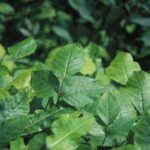
Poison ivy leaves

Poison ivy on a tree

Poison ivy roots
Virginia creeper, Parthenocissus quinquefolia, is an attractive vine that produces bright fall foliage and is commonly found along fences and at the edge of wooded areas. Sometimes confused with poison ivy, it has compound leaves with five leaflets. The small, blue berries provide food for birds and other animals in late summer. It is a popular landscape vine and has been cultivated since the early 1800s.
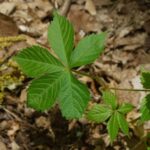
Virginia creeper leaf
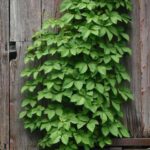
Virginia creeper
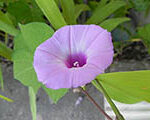
Morning glory
Wild morning glory, Ipomoea cordatotriloba, is the most common Hill Country morning glory. Other names include Purple Bindweed and Tie Vine. Its lavender flowers are funnel-shaped, about 2” wide and sport a deep purple center. They bloom from approximately April – October. Morning glories are considered to be a weed by some gardeners due to their habit of self-seeding from their many seed pods. However, when one or two plants are allowed to grow on a low trellis in the garden, they make a lovely display. Be sure to harvest the seed pods to prevent their spread.
Mustang grape, Vitis mustangensis, is a very common grapevine in central Texas. It is a vigorous grower, climbing high into trees with a trunk base that can grow as large as a small tree. The plants are very heat, drought and disease resistant; they produce sour, dark purple grapes about ¾” in diameter, ripening in June – September. Although the grapes are sour, they can be made into tasty jelly and wine and the birds and deer love them.
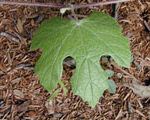
Mustang grape leaf

Mustang grapes